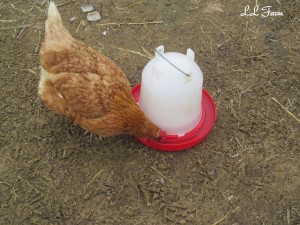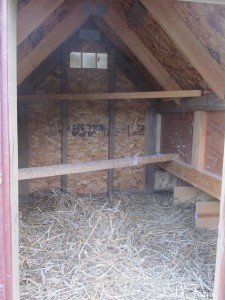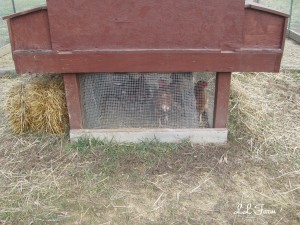Are you worried about your flock for the cold weather that is upon us? Don’t fret! By doing a few things, your chickens will be fine. Remember…chickens are birds, not mammals.
Some things to ponder:
- Chickens have survived winter weather for many many years (before electricity – heated coops and water heaters were not heard of).
- Chickens huddle together to stay warm. I have peaked in on our ladies at night – they are always on the top roost, and are always snuggled close to each other. This is their natural instinct to stay warm.
- For birds of the air, we put feed in bird feeders and water in bird baths. We don’t give them a heated bird house or heated water.
With that said, there are a few things that I do to ensure that my ladies will be okay during the colder months:
1.) Frozen water is something that a lot of people deal with.

I have recently changed from metal back to plastic. The metal water container worked great in the warmer months, keeping the water cooler. But, when it started getting colder, the water seemed to freeze faster. Also, the metal container made it harder to break up the ice and open the container.

Just look at this picture taken after my daughter ‘beat it’, trying to open it so she could give them fresh water.
In my experience, the plastic watering container works better in colder months because if the sun is shining at all, it can penetrate the water so it doesn’t freeze as fast. Something that makes my mornings run a little smoother (but we are not in the habit of doing every night) is taking the watering container in the heated garage at night when we close the chicken coop up.
2.) For inside the coop, there is a vent. Ventilation is necessary to allow fresh air to circulate through the coop. We also keep the small coop door open during the day, while the ladies are out.
Ventilation also lets out moist air that can occur from the chickens droppings. Moist air in the coop can lead to frostbite.
If the coop is airtight (no ventilation), the droppings start to compost and create an ammonia smell. This can lead to respiratory illness.

For the floor, I may go a little longer (than normal time) for cleaning out the coop, adding more straw where they have scratched it thin between cleanings. This acts as insulation.
We close the ladies in at night. This helps to keep the cold wind and predators out.
3.) For outside the coop, the ladies have a fenced in area where they stay safe.

They also have an area under the coop that is also fenced and has a bale of straw to protect against strong bitter winds and blowing snow. Look at them – are they inquisitive or photogenic?
Handy Hubby built an outside roost for the ladies.

This can help to protect their feet from the snow-covered ground, and also gives them a ‘podium’ to speak from (smile).
4.) Although I don’t have as many food scraps to give them as I do in the warmer months (from the garden), I try to supplement their diet as often as I can.

Food scraps from our kitchen are healthy for the ladies at all times, but in the colder months it can be an added natural benefit of vitamins and minerals. We also give our ladies layer pellets twice a day.
With a few precautions taken, chickens can not only survive the cold winter months, but also thrive through the cold winter months.
Happy New Year from LL Farm!













12 Comments
I use the plastic buckets with the heating element built in for winter water for my chickens and other poultry. They sell them at Tractor Supply and through Jeffers Livestock. That way I am always sure my birds have water available even in subzero temps.
I wonder if it would be ok to put a bucket of warm water in the coop in the morning to help warm them up. I take buckets of hot water out to the goats on very cold mornings.
I set up their water like an aquarium with a aquarium heater and air pump to circulate in any plastic or metal bucket.
I heat their water using homemade heaters made of a “cookie can” with a 40 watt light bulb in it. doesn’t really warm the water, just keeps it from freezing. I use heavy bedding of pine shavings in the coop area and close all but the run access door, so it’s pretty snug and windproof. I add straw to the flood of the run and they have a great time scratching around finding the oats left on the heads of the straw. I let them out to range when I can, but the 2 redtail hawks are more apt to visit us in the winter. The girls are healthy and happy.
I have 24 hens and 6 roos. One gal is a house chicken since she came to us with MG and needs to be separate from the rest of the flock. The 29 are housed in 4 coops with attached runs, all have heat panels and are thermostatically controlled. They also have nipple pails that hang close enough to the heat panels to keep from freezing. We also have 4 heated bases for those metal waterers like that which the young lady beat the piss out of and only needed to run some warm water on the latch to quickly break it free to open; the ice slides right out. I had this happen to one just the other day when I forgot to flip the electric switch where one base was plugged in near our back door where the birds come for treats. They do make a plastic waterer that has a heated base as well. Another advantage with my hanging plastic nipple pails is that I can put a cap full of vinegar in it (good for respiratory tract). Vinegar can react with galvanized waterers so I put only water in them. I offer both types of waterers at all times, because your birds need fresh water even more than food. They cannot digest the food they eat without water.
If you have electrical power to your coop, keeping water is not difficult. I use a heated dog water dish, and only need to check/refill the water every few days! It was wind chill -33° here this week, and no frozen water. I only have 6 birds in the coop this year. When I have a larger flock, I use an electric bucket. The birds can very easily reach into it to get water, and I never have to worry about them running out of water. I also leave a light on 24/7 when they are locked inside in the bitter winter.
I keep 3 heated dog water bowls in the coop under the laying boxes. Fresh water goes out with the morning let out, the 11:00 supplemental feeding of kitchen scraps and 1st egg collection, the additional warmth corn feeding and second egg gathering at 3:oo, and final check at last egg collection and lock up at dusk. That’s a lot of water trips, but it helps to have a 2 1/2 gallon cat litter jug for the water, the feed in the overhang at the end of the coop, and an old Christmas goodie basket for the eggs. We currently have 56 laying hens, 5 roosters, and 14 banties.
You’ve got it down Michele. I bet the chickens love the 11:00 slot….when they see you coming with those kitchen scraps.
We use a plastic food grade bucket for the water and put nipples on the bottom of the bucket. We use an aquarium heater in the bucket to keep the water from freezing. Works great.
You have a great system going with the water Richard! Do you think having the light helps them to lay more consistently? It sounds like the dog does a good job paying attention to the flood light too.
I also use plastic winterers in the winter and back to metal in the summer. the plastic one always turn green with algae and hard to clean. In winter I keep three plastic waters. One in the coop and to in the house. The first on goes out in the A.M. and I bring the frozen on back in with me. If I am at home at lunch I trade out again and again when I get home from work. I keep a light on a timer that turn on at 5 am for a couple of hours and back on a 5 pm until about 9. Really do not know if the light helps that much but it makes me feel better. There is also a motion detector flood Light outside the chicken house. JIC. when it comes on the dog always runs to the pen barks a little and back in the pet door if it cold. No much of guard dog and only a 9 pounder but he had fun.
Put a little apple cider vinegar (with the mother) into your plastic containers when refilling water….no more green!